Scientific name: Sempervivum species, Sempervivum tectorum (sem-per-VEE-vum tek-TOR-um)
Common names: hen and chicks, houseleek, devil’s beard, Thor’s beard, thunder plant, healing blade and numerous others
Family: Crassulaceae – stonecrop (krass-yoo-LAY-see-ee)
by Janice Tucker
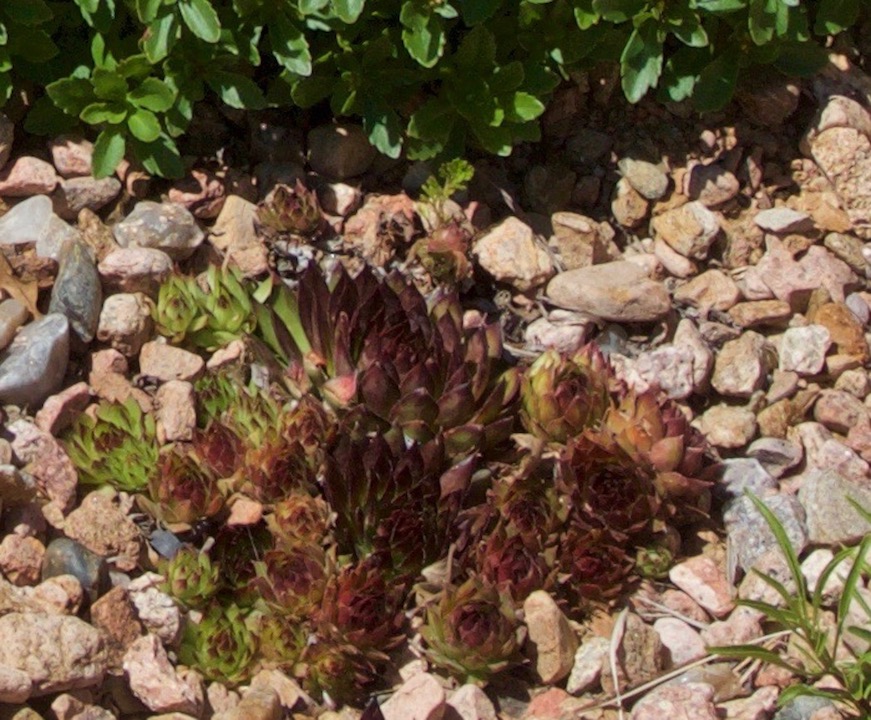
Hen and chicks at Santa Fe Botanical Garden at Museum Hill. Photo credit: Janice Tucker.
What’s in a name? No one took this this question to heart more than Swedish botanist, physician and zoologist, Carl Linnaeus (1707-1778), who developed the binomial system of naming plants and animals still in use today. He is often referred to as the “father of taxonomy”. The names he assigned to plants and animals usually revealed an identifiable characteristic of his subjects. And Linnaeus definitely nailed it when he decided on the generic designation for an intriguing group of plants that are small in stature but persistent in ensuring the advancement of their existence. The fact that these plants constantly reproduced may have been the “aha” moment that inspired him to call the genus Sempervivum, from the Latin semper,”always” and vivus, “living”. Over the centuries, the Sempervivum species have justified bearing a name that means, “always living”.
The Sempervivum is native to central and southern Europe as well as parts of north Africa but it seems to have donned its traveling shoes in order to settle in many other areas throughout the world, including North America. Today there are 40-plus species of Sempervivum as well as numerous hybrids and cultivars. Hardy in USDA Zones 5 to 8, the Sempervivum tectorum adapts well to the intense, dry summer heat and cold winters of the southwestern United States.
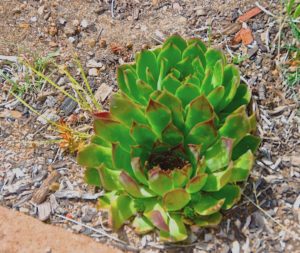
Sempervivum tectorum leaves. Photo credit: Janice Tucker.
The S. tectorum is a hardy succulent with a unique appearance and proclivity to spread, but not to the point that it becomes invasive. It can be tucked into rock gardens, accent xeric areas, planted as a distinctive ground cover, grace an outdoor wall and even adorn rooftops. It makes an attractive container plant on a sunny window sill or patio. As a perennial evergreen it yields year-round garden interest since there is no dying back and waiting for it to re-emerge in the spring.
Although there are several plants that share the common name of hen and chicks it is the best vernacular for the Sempervivum in describing the plant’s growth behavior and asexual reproduction process. Ground-hugging rosettes with fleshy pointed leaves sprout directly from the root. Leaf color can vary on the rosettes in the same colony from green rimmed in red to a combination of bronze and green. The first rosette, known as the hen, sends out several lateral, above the ground roots (stolons) that produce small, almost identical, rosettes, which are the chicks. The chicks will mature to mirror the action of the mother rosette with each becoming the hen with its own chicks. And so it goes until they eventually form a thick mat of different sized rosettes, creating a three-dimensional mosaic of hen and chicks.

Mat of hens and chicks, photo courtesy of Nell Foster joyusgarden.com
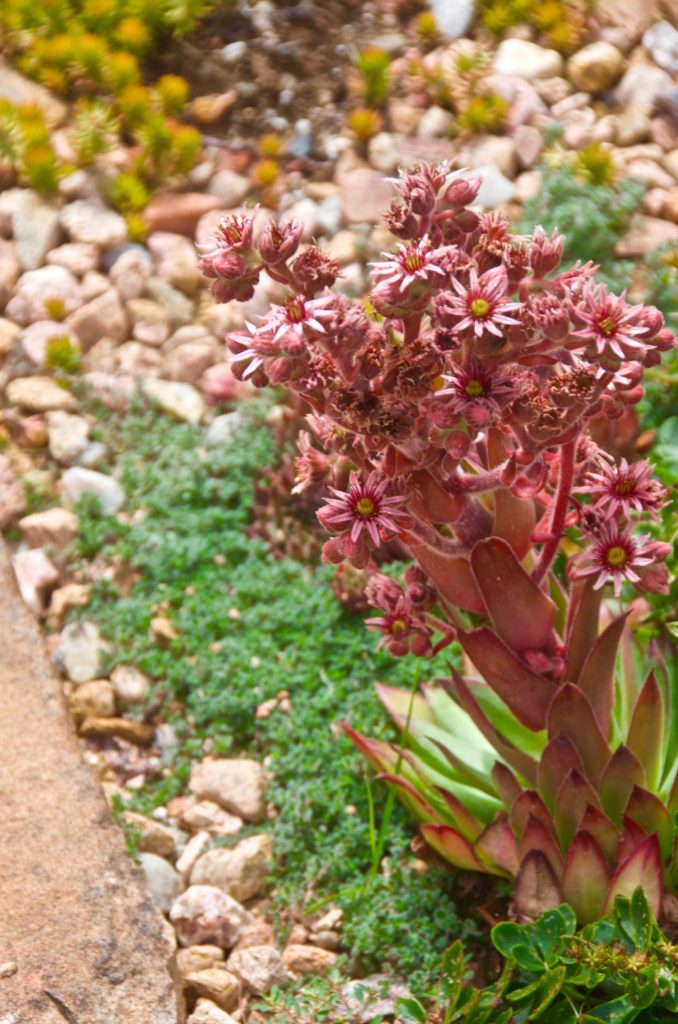
Sempervivum tectorum Hen and chicks flowers (Photo: J Tucker)
A rosette will bloom only once in its lifetime (monocarpic), which usually happens after 2 or 3 years. This begins the Sempervivum’s sexual reproduction phase. In mid to late summer, clusters of pinkish or yellowish flowers branch out from a tall, thick stem lined with vertical, upward pointing leaves. These blooms consist of about 10-12 petals in a starburst pattern that surround a yellow disk center. The flowers are perfect (hermaphrodite) but develop the red stamens (male) stage first. When the carpels (female) have matured, the stamens will bend away from the carpels, making it difficult for the flowers to self-pollinate. The flowers signal that the rosette is nearing the end of its life cycle. The rosette will die after seed dispersal, bequeathing one last gift to the established Sempervivum colony in an effort to achieve the goal to be always living.
The Sempervivum is highly variable, making it difficult to differentiate between some of the species. Cross-pollination is evidenced by slight differences among the rosettes. There are two Sempervivum species in the Botanical Garden at Museum Hill in Santa Fe, New Mexico. The S. tectorum is located in the Meadow Garden, several locations in the Orchard Perennial Borders and in the Xeric Garden. The S. arachnoideum, which grows in the Meadow Garden, stands out from other species due to its cobwebbed foliage. Learn more and locate these plants with the Garden Explorer >
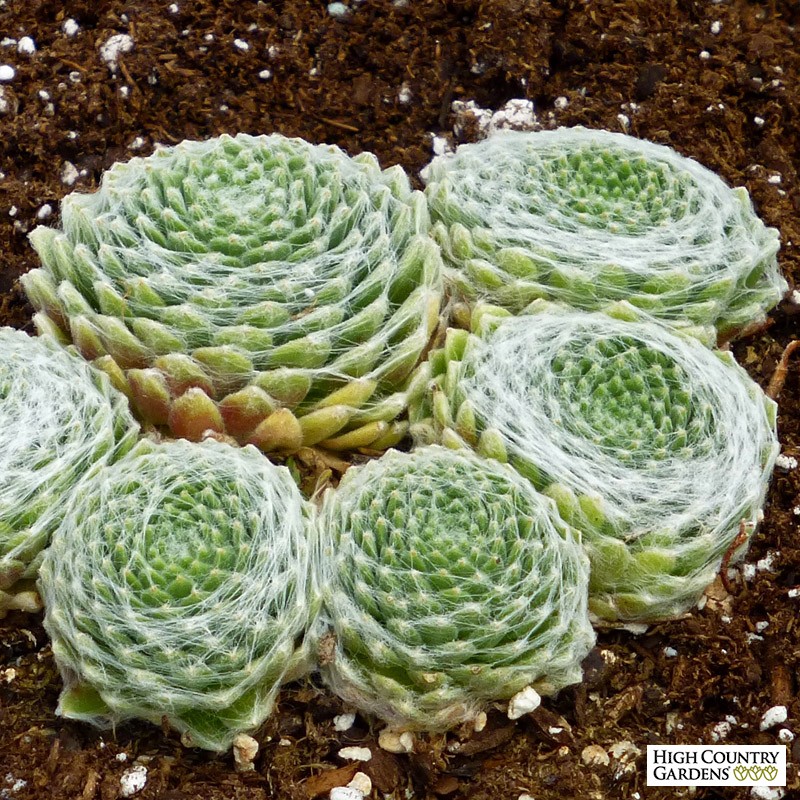
Sempervivum arachnoideum, Cobweb Hen and Chicks. Photo courtesy highcountrygardens.com
Today the Sempervivum tectorum is primarily planted as an ornamental ground cover, a rock garden resident and sometimes used to adorn an outdoor wall. But there is a charming historical use best described by both the specific tectorum and the common name of houseleek, which has nothing to do with the leek vegetable. Tectorum is from the Latin, defined as, “on the roof”. Houseleek is derived from the Anglo-Saxon, leac, which means, “houseplant”. To avoid confusion, houseplant in this instance is not a potted plant but is literally a part of the house, namely the roof. Even now the houseleek can be found throughout Great Britain where it grows on many old cottage rooftops.
Although the S. tectorum is rich in folklore, there’s not enough space to relate all the stories. But following are a few short, engaging tales: Welsh peasants believed the houseleek would protect their houses from storms and that those who lived beneath those rooftops would prosper. Rural residents of Wiltshire, England, were convinced that bad luck, even death, would befall residents of a home if any part of a houseleek was removed from the roof. Old legends do not die easily, and there may be those who still hold to that belief. Another anecdote tells of a botanist who picked a houseleek from his roof to add to his herbarium. But after a long wait, the plant refused to dry. So he gave up and returned the houseleek to the roof where it promptly took root and went on about its business of….always living.
There are numerous other common names for the S. tectorum, several of which surround superstitions, myths and medicinal uses. The reason for common plant names is all over the map. The best way to deal with them is to choose one and stick with it. One source mentioned a common name of “welcome-home-husband-though-never-so-drunk”. Whatever could have inspired that name for the S. tectorum?
Medicinal uses are many and varied. Topical applications as well as internal elixirs claim to relieve symptoms for a litany of ailments. Be aware that ingesting too much S. tectorum can cause extreme nausea and diarrhea. Maybe it’s best to stick with modern-day remedies unless you are proficient in herbal medicine. The meaning of always living refers to the plant, not necessarily to those who partake of it.
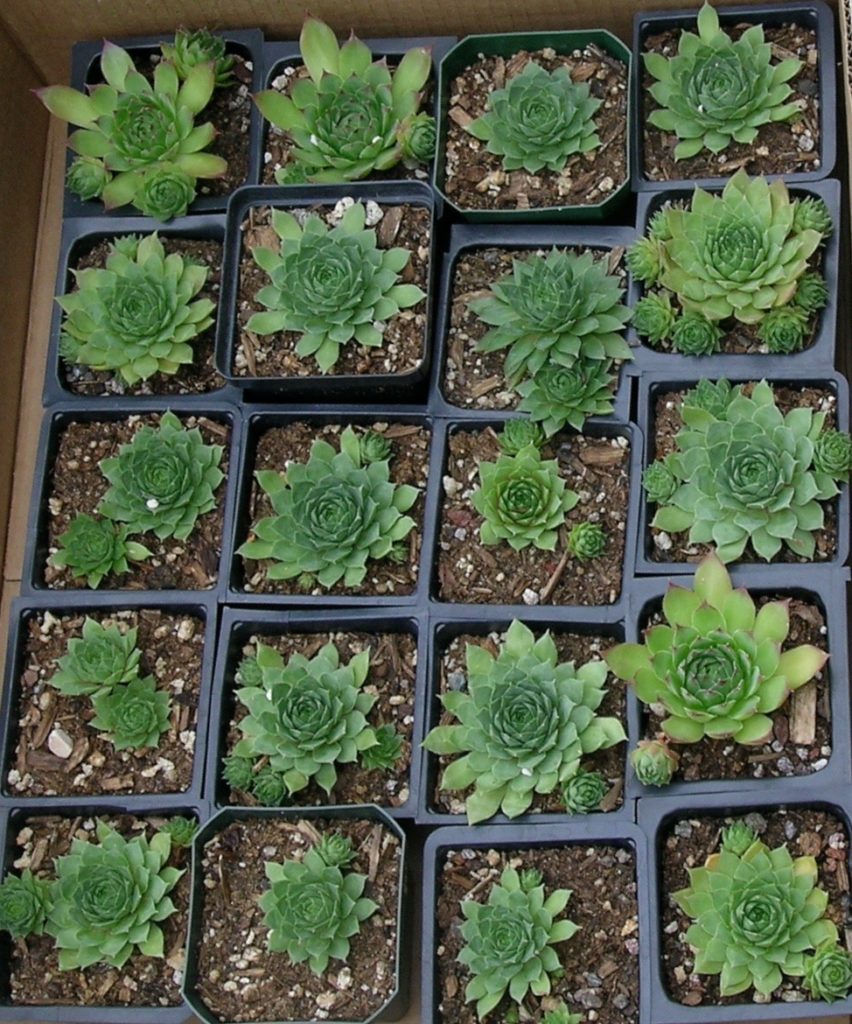
Sempervivum tectorum Hen and Chicks ready for planting (Photo: J Tucker).
Choose a sunny spot for the Sempervivum tectorum whether opting for a potted plant, a wall, a ground cover or even a rooftop. It has a preference for low fertility soil as long as it drains well and that’s good news for Santa Fe gardeners since that type of soil is easy to come by in our area. Its plump leaves retain water, which allow it to survive in drought conditions. Once established, there is usually no need for supplemental water when planted outdoors. Pollinators such as butterflies and other insects are attracted to the flowers. Most sources claim it is free from pests and diseases. Deer usually do not bother it nor do rabbits. But personal experience attests to the claim that rabbits will dine on a freshly planted S. tectorum. Perhaps a short-term protective cover is in order until the plant is firmly rooted. Removing spent flower stalks after the rosette has died will ensure a neat appearance and the space will be filled with newly sprouted rosettes. That’s about it for maintenance.
Here in Santa Fe we seek out unique plants that thrive in our challenging climate as well as those that emphasize our determination to have a garden that is Semper vivus: Always living.
Thanks to Helen Woody and Jeanne Gozigian for proofreading this article.
Sources consulted:
Foster, Nell, Joy US Garden website, Hens and Chicks, The Succulent That Keeps On Giving
https://www.joyusgarden.com/hens-and-chicks-succulent/ .
Grieve, M. Mrs., Botanical.com website, Houseleek,
https://www.botanical.com/botanical/mgmh/h/houlee41.html .
High Country Gardens website, Sempervivum arachnoideum, Cobweb Hen and Chicks,
https://www.highcountrygardens.com/perennial-plants/unique-plants/cobweb-sempervivum-archnoides.
Missouri Botanical Garden, Sempervivum tectorum,
http://www.missouribotanicalgarden.org/PlantFinder/PlantFinderDetails.aspx?kempercode=b711.
Santa Fe Botanical Garden Garden Explorer Plant Database website:
Sempervivum tectorum, https://santafebotanicalgarden.gardenexplorer.org/taxon-652.aspx
Sempervivum arachnoideum, https://santafebotanicalgarden.gardenexplorer.org/taxon-989.aspx .
SEINet Arizona-New Mexico Chapter website, Sempervivum tectorum,
http://swbiodiversity.org/seinet/taxa/index.php?taxon=Sempervivum+tectorum&formsubmit=Search+Terms
University of California Museum of Paleontology, Carl Linnaeus


